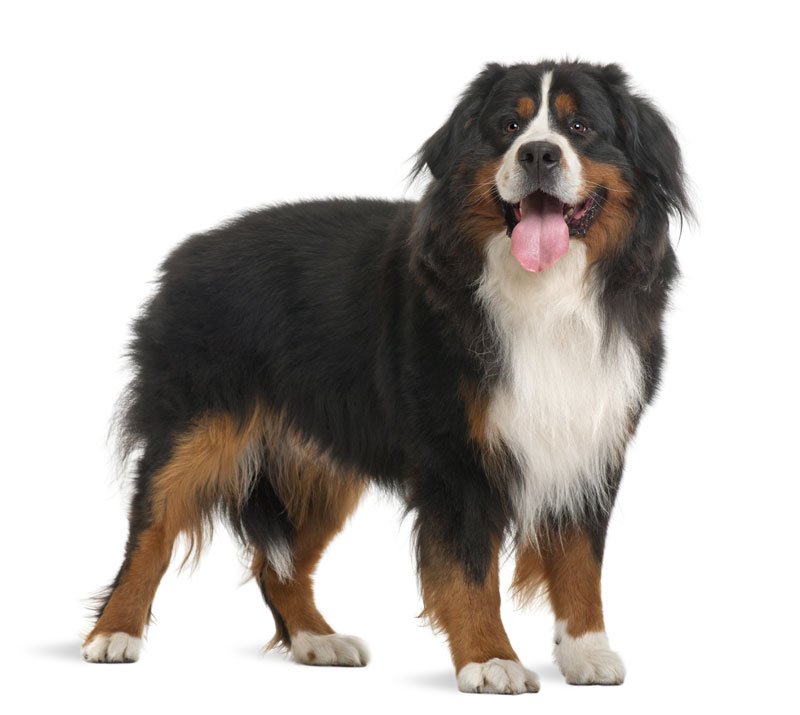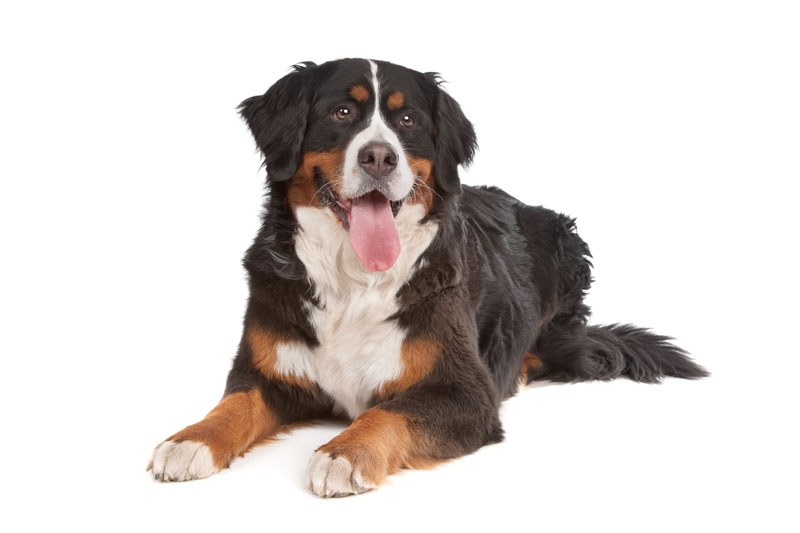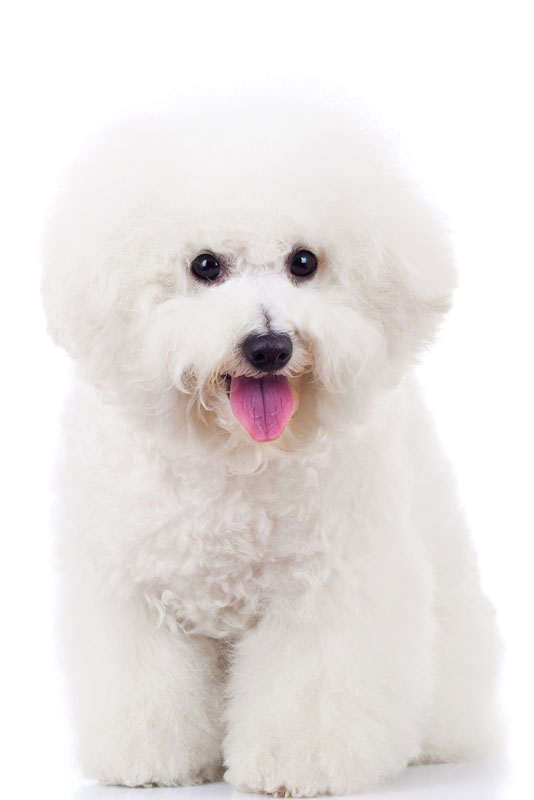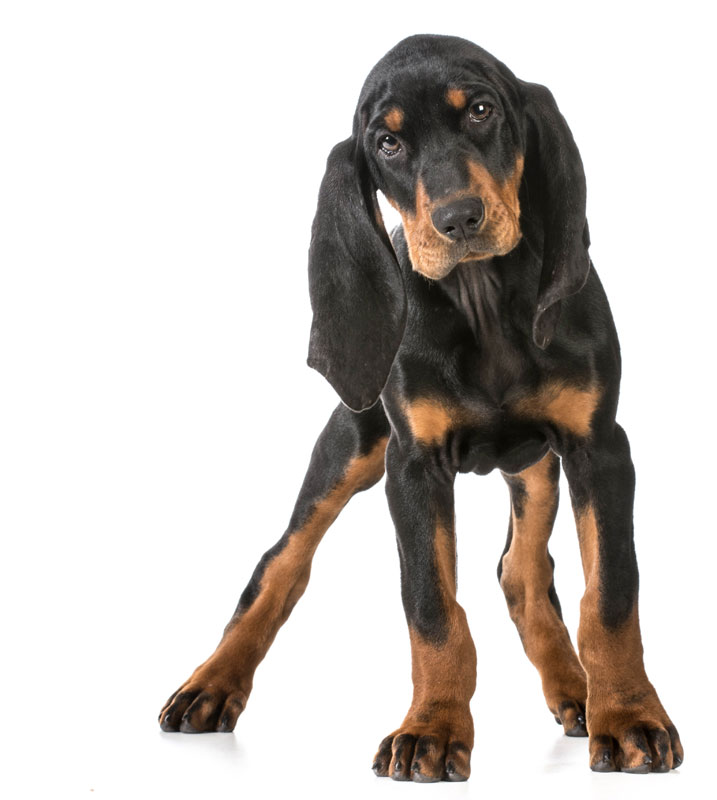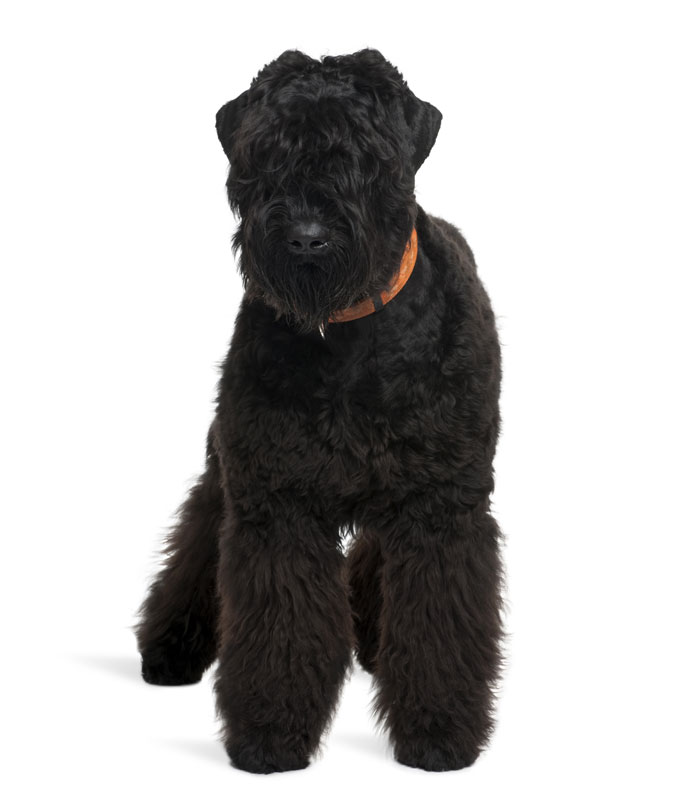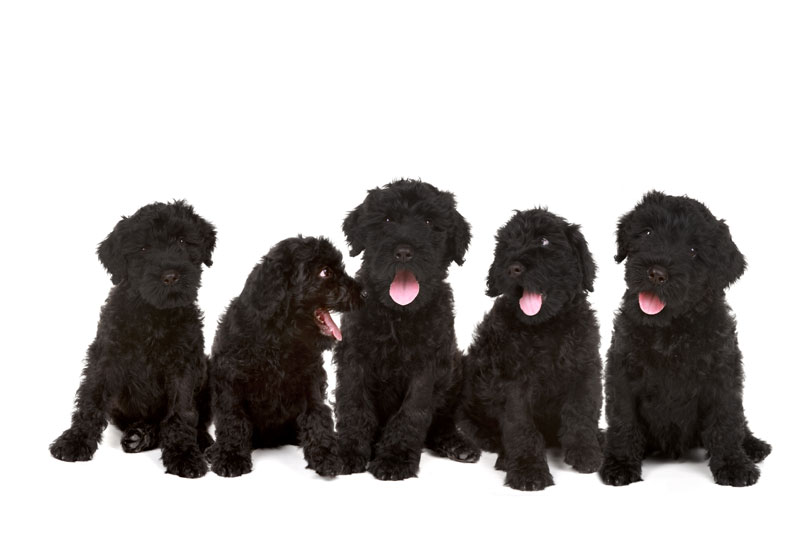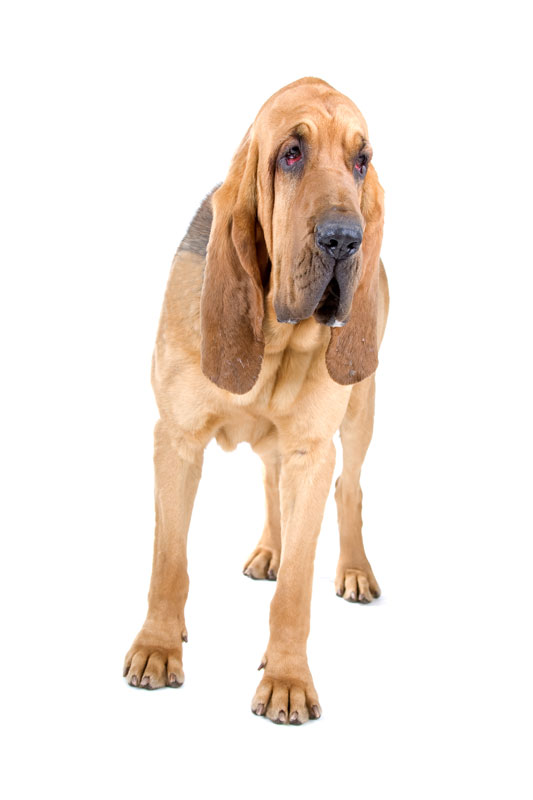Super User
Bernese Mountain Dog
The Bernese Mountain Dog, called in German language the Berner Sennenhund, is a large breed of dog, one of the four breeds of Sennenhund-dog type dogs from the Swiss Alps. The name Sennenhund is derived from the German Senne (“alpine pasture”) and Hund (“dog”), as they accompanied the alpine herders and dairymen called Senn. Berner (or Bernese in English) refers to the area of the breed’s origin, in the canton of Bern in Switzerland. This mountain dog was originally kept as a general working dog. Large Sennenhunds in the past were also used as draft animals, pulling carts. The breed was officially established in 1907. In 1937, the American Kennel Club recognized it as a member of the Working Group.
Height and weight ranges
Height at the withers is 63.5cm - 69.9cm for males, while it is 58.4cm - 66cm for females. Weight is 38.6kg - 49.9kg for males, while it is 36.3kg - 47.6kg for females. They are patient dogs that take well to children climbing over them.The breed was used as an all purpose Working dog for guarding property and to drive dairy cattle long distances from the farm to the alpine pastures. The type was originally called the Dürrbächler, for a small town (Dürrbach) where the large dogs were especially frequent. In the early 1900s, Animal fancy exhibited the few examples of the large dogs at conformation show in Berne, and in 1907 a few breeders from the Burgdorf region founded the first breed club, the Schweizerische Dürrbach-Klub, and wrote the first breed standard which defined the dogs as a separate breed. By 1910, there were already 107 registered members of the breed. There is a photo of a working Bernese Mountain Dog, dated 1905 at the Fumee Fall rest area in Quinnesec, MI.In the US, the Bernese Mountain Dog is growing in popularity, ranking in 32nd place by the American Kennel Club in 2013.
Health
Medical issues
Cancer is the leading cause of death for dogs in general, but Bernese Mountain Dogs have a much higher rate of fatal cancer than other breeds; in both U.S./Canada and UK surveys, nearly half of Bernese Mountain Dogs die of cancer,
compared to about 27% of all dogs. The average life expectancy of a Bernese Mountain Dog in the United States used to be 10–12 years, but it has decreased significantly to 6–8 years, with the median being 7.2 years. Bernese Mountain Dogs also have a median longevity of around seven years in Denmark and Canada, while in the United Kingdom the median is eight. In a 2004 UK survey, the longest-lived of 394 deceased Bernese Mountain Dogs died at the age of 15.2 years.
Bichon Frisé
A Bichon Frisé (/ˈbiʃɒn ˈfriz/ or /ˈbiʃɒn frɪˈzeɪ/; French, meaning curly lap dog), is a small breed of dog of the Bichon type. The Bichon Frise is a member of the Non-Sporting Group of dog breeds in the US, and a member of the Toy Dog group in the UK.
The Bichon Frisé descended from the Barbet or Water Spaniel and the Standard Poodle. The word bichon comes from Middle French bichon ("small long-haired dog"), a diminutive of Old French biche ("bitch, female dog"), from Old English bicce ("bitch, female dog"), related to Old Norse bikkja ("female dog") and German Betze ("female dog"). Some speculate the origin of bichon to be the result of the apheresis, or shortening, of the word barbichon ("small poodle"), a derivative of barbiche ("shaggy dog"); however, this is unlikely, if not impossible, since the word bichon (attested 1588) is older than barbichon (attested 1694). Bichons were first bred around the year 1300, in France; the queen at the time named them Bichon Frise. They were the result of breeding her poodle and a Maltese. They were the Queen's lapdog.
The Bichons were divided into four categories: the Bichon Maltese, the Bichon Bolognaise, the Bichon Havanese and the Bichon Tenerife. All originated in the Mediterranean area. Because of their merry disposition, they traveled much and were often used as barter by sailors as they moved from continent to continent. The dogs found early success in Spain and it is generally believed that Spanish seamen introduced the breed to the Canary Island of Tenerife. In the 14th century, Italian sailors rediscovered the little dogs on their voyages and are credited with returning them to the continent, where they became great favorites of Italian nobility. Often, as was the style of the day with dogs in the courts, they were cut "lion style," like a modern-day Portuguese Water Dog.
Though not considered a retriever or water dog, the Bichon, due to its ancestry as a sailor's dog, has an affinity for and enjoys water and retrieving. On the boats however, the dog's job was that of a companion dog.
The "Tenerife", or "Bichon", had success in France during the Renaissance under Francis I (1515–1547), but its popularity skyrocketed in the court of Henry III (1574–1589). The breed also enjoyed considerable success in Spain as a favorite of the Infantas, and painters of the Spanish school often included them in their works. For example, the famous artist, Francisco de Goya, included a Bichon in several of his works.
Interest in the breed was renewed during the rule of Napoleon III, but then waned until the late 19th century when it became the "common dog", running the streets, accompanying the organ grinders of Barbary, leading the blind and doing tricks in circuses and fairs.
On 5 March 1933, the official standard of the breed was adopted by the Société Centrale Canine, the national kennel club for France. This was largely due to the success of the French-speaking Belgian author Hergé's The Adventures of Tintin, which featured a small, fluffy, white fox terrier dog named Milou (Snowy in the English editions). As the breed was known by two names at that time, "Tenerife" and "Bichon", the president of the Fédération Cynologique Internationale proposed a name based on the characteristics that the dogs presented – the Bichon Frisé. ("Frisé" means "curly", referring to the breed's coat.) On 18 October 1934, the Bichon Frisé was admitted to the stud book of the Société Centrale Canine.
The Bichon was popularized in Australia in the mid-1960s, largely thanks to the Channel Nine mini-series Meweth, starring Bruce Gyngell alongside his pet Bichon, Molly. The show ran for one season only, however it gained a cult following. In subsequent years Bichon ownership, especially in the Eastern states, climbed dramatically.
The Bichon was brought to the United States in 1955. The first US-born Bichon litter was whelped in 1956. In 1959 and 1960, two breeders in different parts of the USA acquired Bichons, which provided the origins for the breed's development in the USA.
The Bichon Frise became eligible to enter the AKC's Miscellaneous Class on 1 September 1971. In October 1972, the breed was admitted to registration in the American Kennel Club Stud Book. On 4 April 1973, the breed became eligible to show in the Non-Sporting Group at AKC dog shows. In 2001, a Bichon Frise named JR won best-in-show at the Westminster Kennel Club Dog Show. In the United States the Bichon Frise was ranked the 40th most popular breed in 2013 according to the American Kennel Club.
Bichon Frises often appear on lists of dogs that do not shed (moult). The grooming required to maintain the Bichon Frise's coat helps remove loose hair, and the curl in the coat helps prevent dead hair and dander from escaping into the environment, as with the poodle's coat. The frequent trimming, brushing, and bathing required to keep the Bichon looking its best removes hair and dander and controls the other potent allergen, saliva.
It is best to have a Bichon Frise groomed approximately every four to eight weeks. Daily brushing of the coat helps to prevent matting. If a Bichon's coat gets severely matted, they may develop a hematoma, most likely in the ears.
Bichon Frises are considered suitable for people with allergies, as they are bred to be hypoallergenic. It is important to note that human sensitivity to dog fur, dander, and saliva varies considerably. Although hair, dander, and saliva can be minimized, they are still present and can stick to "clothes and the carpets and furnishings in your home"; inhaling the allergens, or being licked by the dog, can trigger a reaction in a sensitive person.
Lifespan
Bichon Frise in (combined) UK and USA/Canada surveys had an average life span of about 12–13 years, with Bichon Frises in the UK tending to live longer than Bichon Frises in the US/Canada. This breed's longevity is similar to other breeds of its size, and somewhat longer than purebred dogs in general. The longest lived of 34 deceased Bichons in a 2004 UK survey died at 16.5 years.
The oldest Bichon Frises for which there are reliable records in various US/Canada surveys have died at 19 years.
In a 2004 UK Kennel Club survey, the leading causes of Bichon Frise death were old age (23.5%) and cancer (21%). In a 2007 USA/Canada breeders survey, the leading causes of death were cancer (22%), unknown causes (14%), hematologic (11%), and old age (10%). Hematologic causes of death were divided between autoimmune hemolytic anemia (AIHA) and immune-mediated thrombocytopenia (ITP). AIHA and ITP were responsible for the greatest amount of Bichon Frise "years lost." "Years lost" is a measure of the extent to which a condition kills members of a breed prematurely. While cancer is a more common cause of death than AIHA/ITP, Bichon Frises that died of cancer died at a median age of 12.5 years. Hematologic deaths occurred at a median age of only 5 years. Bichon Frises in the UK survey had a lower rate of hematologic deaths (3%) than in the USA/Canada survey (11%).
Bichons are also prone to liver shunts. These often go undetected until later in life, leading to complications that cannot be fixed, and therefore liver failure. Bichons who are underweight, runts of the litter, or have negative reactions to food high in protein are likely to be suffering from a shunt. When detected early, shunt often can be corrected through surgery. However, the later in life the shunt is detected, the lower the likelihood of surgery being a success. Shunts can be kept under control through special diets of low protein and through medications to support liver function, help flush toxins that build up in the kidneys and liver, and control seizures that often occur as a symptom of the shunt. Without surgery, Bichons with shunts on average live to be 4–6 years old. Owners of a smaller than average size bichon must consult a vet. Other symptoms include dark urine, lethargy, loss of appetite, increase in drinking. Seizures come in all forms; episodes of seizures can begin early on but go undetected. Early seizures can appear to be the bichon in a hypnotic state (staring at something not there), or to be experiencing an episode of vertigo, or being drunk. Shunts are a serious condition of smaller breeds, and often not associated with Bichons.
AIHA and ITP
Because autoimmune hemolytic anemia (AIHA, also called immune-mediated hemolytic anemia, or IMHA) and immune-mediated thrombocytopenia (ITP) are responsible for premature Bichon Frise deaths, Bichon Frise owners should be particularly alert to the symptoms of these conditions. In AIHA, the dog's immune system attacks its own red blood cells, leading to severe, life-threatening anemia. Symptoms include weakness, loss of energy, lack of appetite, vomiting, diarrhea, rapid heart rate, rapid breathing, dark urine, and pale or yellow gums. Thrombocytopenia often accompanies AIHA. In ITP, blood platelets (which cause blood clotting) are destroyed. The most common clinical signs are hemorrhages of the skin and mucus membranes. Owners of Bichon Frises showing suspicious symptoms should seek immediate veterinary care as these diseases can strike with little or no warning and kill very quickly. Mortality rates of 20% to 80% are reported.
Billy
A Billy is a large scenthound originating from central western France. The Billy remains a rare breed, although there are several packs in its native France used to hunt the Roebuck, and two packs to hunt Wild boar.
History
The Billy was created by Monsieur Gaston Hublot de Rivault in the 19th century, and was named after his home the Château de Billy, in Poitou. Billys we created by combining the three original strains of the Poitevin, the Montemboeuf, Ceris and Larrye. Whereas the modern Poitevin more closely resembles and the original Tri-coloured Larrye line, Rivault was more drawn to the paler colours associated with the Montemboeuf and Ceris lines, and colouration was a major determinant when selecting foundation stock. The pack was dispersed in 1927 and the breed almost faced extinction, only two hounds survived World War II, however de Rivault's son, Anthony, set about reviving the breed by judicious use of the Poitevin, the Porcelaine and the Harrier.
The Billy was one of the foundation breeds used in the development of the Grand Anglo-Français Blanc et Orange in the late 19th century.
Birman
The Birman, also called the "Sacred Cat of Burma", is a domestic cat breed. The Birman is a long-haired, point coloration cat distinguished by a silky coat, deep blue eyes and contrasting white "gloves" on each paw.The breed name is derived from Birmanie, the French form of Burma. The Birman breed was first recognized in France by the Cat Club de France in 1925, then in England by the Governing Council of the Cat Fancy (GCCF) in 1966 and in United States by the Cat Fanciers' Association (TICA) in 1979.
History
There is no clear record of the breed's origin. They are most often claimed to have originated as the companions of temple priests in Northern Burma in the Mount of Lugh. Another pair of Birmans (or a pregnant female called Poupée de Maldapour) were said to have been stolen and later imported to France by Thadde Haddisch. The first traces of historical Birmans go back to a Mme Leotardi in the city of Nice in France.Birmans were almost wiped out as a breed during World War II. Only two cats were alive in Europe at the end of the war, a pair named Orloff and Xenia de Kaabaa, both belonging to Baudoin-Crevoisier. The foundation of the breed in postwar France were offspring of this pair. They had to be heavily outcrossed with long-hair breeds such as Persian (cat) and Siamese to rebuild the Birman breed. By the early 1950s, pure Birman litters were once again being produced. The restored breed was recognized in Britain in 1965 and by the CFA in 1966.The first Birman cats were seal point. The blue point colour was introduced in 1959 using blue Persian lines. New colours were later added by English breeders including chocolate, red, and lynx (tabby) points. Birmans have also been used in the development of new breeds, notably including the Ragdoll.
Health
The most severe threat is feline hypertrophic cardiomyopathy (HCM), the most common heart disease seen in cats. In Birman cats, it is thought to be inherited as an autosomal dominant trait. HCM is a progressive disease and can result in heart failure, paralysis of the hind legs due to clot embolization originating in the heart, and sudden death.
Black and Tan Coonhound
The Black and Tan Coonhound is a breed of dog used principally for trailing and treeing raccoon. It's a cross between the Bloodhound, and the Black and Tan Virginia Foxhound. The Black and Tan Coonhound runs its game entirely by scent. The courage of the Coonhound also make it proficient on the hunt for deer, bear, cougar and other big game, although many US states are restricting the hunting of antlered animals with dogs. The general impression is that of power, agility and alertness, with the ability to cover ground swiftly with powerful rhythmic strides. Each hound has its own distinctive voice which is often recognizable to its owners from great distance.
Black and Tan Virginia Foxhound
The Black And Tan Virginia Foxhound is an United States dog breed; one of four foxhound breeds. In the 18th century it was crossbred with the Bloodhound, and gave rise to the Black and Tan Coonhound. It is also good for fox hunting.
History
The Black and Tan Virginia Foxhound is an American foxhound breed. It resulted of a cross breed with Bloodhounds in the 1700s. The breed was developed by the landed gentry in order to get a dog suitable for fox hunting, so most American foxhounds were born. Besides the Black and Tan there are the Walker Foxhound, Calhoun, Penn-Marydel, Goodman Foxhound, July and Trigg Foxhound. The Black and Tan is believed to descend form hunting dogs imported to America by Robert Brooke, Sr. in 1650. These hunting dogs were the ancestors of several varieties of American hounds and stayed with the Brooke family for more than 300 years. Afterwards French Foxhounds were bred in after George Washington received them as gifts from the Marquis de Lafayette. Much later, the breed's speed and stamina were improved introducing Irish Foxhounds.
Black Norwegian Elkhound
The Black Norwegian Elkhound (Norsk Elghund Sort) is a modern variant of the Grey Norwegian Elkhound. It is a small Spitz breed and is very rare outside the Nordic countries of Scandinavia. It is bred for the same purpose as the Grey Norwegian Elkhound but is smaller, more agile, and easier to recognize in the snow. Historically, it is a much "younger" breed, first bred in Norway during the early 19th century. It is classified by the Fédération Cynologique Internationale as a hunting dog, although it is also used as a watchdog, guarddog and herder.The American Kennel Club breed name "Elkhound" comes directly from its original Norwegian name "Elghund" meaning "moose dog." In Norwegian, "elg" refers to the animal English speakers know as a "moose", and "hund" means "dog."
Black Russian Terrier
The Black Russian Terrier, abbreviated as BRT or Stalin's dog (Sobaka Stalina) is a dog breed of dog, developed to serve as guard dog and police dog. It is rare outside the countries of the former Soviet Union but beginning to be formally recognized elsewhere: in July 2004, for instance, it became one of the American Kennel Club recognized breeds due to the efforts of Trident Kennels now located in Oregon.Despite its name, the Black Russian Terrier is not a true terrier: it is believed that about twenty breeds were used in its development, including the Airedale Terrier, the Giant Schnauzer, the Rottweiler, the Newfoundland dog, the Caucasian Shepherd Dog and the now extinct Moscow Water Dog.
History
The Black Russian Terrier was developed in the former Soviet Union by the state for use as a military/working dogs. The breeding stock was largely imported from the occupied countries, especially East Germany. Breeds used in the development include the Airedale Terrier, Caucasian Ovcharka, Newfoundland, Giant Schnauzer and Standard Schnauzers and the now extinct Moscow Water Dog. BRT were bred for working ability, rather than appearance, and early examples only resembled today's Black Russian Terrier in their build and coat type. The BRT was bred solely by the state owned Red Star Kennel until 1957, when some puppies were sold to civilian breeders. These breeders began to breed for looks (as the original was rather plain) while retaining working ability. In time, the breed spread to the Balkans, Ukraine, and Siberia, and later to Finland, Hungary, Czechoslovakia, and the United States.The breed was recognized by the Fédération_Cynologique_Internationale in 1984. On July 1, 2004, it was recognized by the American Kennel Club [AKC] in the Working Group. The Canadian Kennel Club has the Black Russian Terrier as a "listed" (formally Miscellaneous Class) breed in the Working Group.
Health
The Black Russian Terrier is a generally healthy and somewhat long-lived dog (lifespan of 10–14 years), however it is prone to certain Genetic disorder:Major concerns* Hip dysplasia (canine)
* Elbow dysplasia
* HyperuricosuriaMinor concerns* Progressive retinal atrophy (PRA) In an interview with Optigen staff in 2012, they do not recall ever having a Black Russian Terrier reported to them.This is why it is extremely important to screen any potential breeders as well as their breeding stock. A well intended breeder will have all health checks on all breeding stock before making the decision to breed their dogs. While health checks on breeding stock can not guarantee a puppy will not develop any health issues later on, it is important to "do your homework" on any potential breeder.
Bloodhound
The Bloodhound is a large scent hound originally bred for hunting deer and wild boar, but also used from the Middle Ages onwards for tracking human beings, and now most often bred specifically for that purpose. Thought to be descended from hounds once kept at the Abbey of St Hubert in Belgium, it is known to French speakers as the Chien de Saint-Hubert.This dog is famed for its ability to discern human odors even days later, over great distances, even across water. Its extraordinarily keen olfaction is combined with a strong and tenacious tracking instinct, producing the ideal scent hound, and it is used by police and law enforcement all over the world to track escaped prisoners, missing people, lost children and lost pets.
Health
Illnesses
Compared to other purebred dogs, Bloodhounds suffer an unusually high rate of gastrointestinal ailments, with bloat being the most common type of gastrointestinal problem. The breed also suffers an unusually high incidence of eye, skin, and ear ailments; The oldest of the 82 deceased dogs in the survey died at the age of 12.1 years. Bloat took 34% of the animals, making it the most common cause of death in Bloodhounds. The second leading cause of death in the study was cancer, at 27%; this percentage is similar to other breeds, but the median age of death was unusually young (median of about 8 years).Whether they originated there or what their ancestry was, is uncertain, but from ca. 1200, the monks of the Abbey of St Hubert annually sent several pairs of black hounds as a gift to the King of France. They were not always highly thought of in the royal pack. Charles IX of France 1550-74, preferred his white hounds and the larger Chien-gris, and wrote that the St Huberts were suitable for people with gout to follow, but not for those who wished to shorten the life of the hunted animal. He described them as pack-hounds of medium stature, long in the body, not well sprung in the rib, and of no great strength. Writing in 1561 Jaques du Fouilloux describes them as strong of body, but with low, short legs. He says they have become mixed in breeding, so that they are now of all colours and widely distributed. Charles described the 'true race' of the St Hubert as black, with red/tawny marks above the eyes and legs usually of the same colour, suggesting a 'blanket' black and tan (see Section on Bloodhound#Colour types below). To De Fouilloux the 'pure black' were the best of this mixed breed. Both writers thought them only useful as leash hounds. They both refer to a white hound, also a St Hubert, which by their time had disappeared, having been interbred with another white hound, the greffier, to produce the king’s preferred pack hound, sometimes called the chien blanc du roi.They appear to have been more highly thought of during the reign of Henry IV of France (1553–1610), who presented a pack to James I of England. By the end of the reign of Louis XIV (1715), they were already rare. In 1788, D’Yauville, who was master of the Royal hounds, says those sent by the St Hubert monks, once much prized, had degenerated, and scarcely one of the annual gift of six or eight was kept.Upon the French Revolution of 1789, the gifts ceased, and hunting in France went into a decline until the end of the Napoleonic wars. When it recovered during the 19th Century, huntsmen, with many breeds to choose from, seem to have had little interest in the St Hubert. An exception was Baron Le Couteulx de Canteleu, who tried to find them. He reported that there were hardly any in France, and those in the Ardennes were so cross-bred that they had lost the characteristics of the breed.
Bloodhound
References to bloodhounds first appear in English writing in the early to mid 14th century, in contexts that suggest the breed was well established by then. It is often claimed that its ancestors were brought over from Normandy by William the Conqueror, but there is no actual evidence for this. That the Normans brought hounds from Europe during the post-Conquest period is virtually certain, but whether they included the Bloodhound itself, rather than merely its ancestors, is a matter of dispute that probably cannot be resolved on the basis of surviving evidence.In Medieval hunting#Hound the Dog type of the Bloodhound was as a ‘limer’ or ‘lyam-hound’, that is a dog handled on a leash or ‘lyam’, to find the hart (deer) or Wild boar before it was hunted by the pack hounds (raches). It was prized for its ability to hunt the cold scent of an individual animal, and, though it did not usually take part in the kill, it was given a special reward from the carcass.It also seems that from the earliest times the Bloodhound was used to track people. There are stories written in Medieval Scotland of Robert the Bruce (in 1307), and William Wallace (1270–1305) being followed by 'sleuth hounds’. Whether true or not, these stories show that the sleuth hound was already known as a man-trailer, and it later becomes clear that the sleuth hound and the Bloodhound were the same animal.In the 16th century, John Caius, in unquestionably the most important single source in the history of the Bloodhound, describes its hanging ears and lips, its use in game parks to follow the scent of blood, which gives it its name, its ability to track thieves and poachers by their foot scent, how it casts if it has lost the scent when thieves cross water, and its use on the Scottish borders to track cross-border raiders, known as Border Reivers. This links it to the sleuth hound, and from Caius also comes the information that the English Bloodhound and the sleuth hound were essentially the same, though the Bloodhound was slightly bigger, with more variation in coat colour.The picture on the right was published in Zurich in 1563, in Conrad Gesner's Thierbuch (a compendium of animals) with the captions: 'Englischen Blüthund' and 'Canis Sagax Sanguinarius apud Anglos' (English scent hound with associations of blood). It was drawn by or under the supervision of, John Caius, and sent to Gesner with other drawings to illustrate his descriptions of British dogs for European readers. It is thus the earliest known picture published specifically to demonstrate the appearance of the Bloodhound. We are told it was done from life,With the rise of fox-hunting, the decline of deer-hunting, and the extinction of the wild boar, as well as a more settled state of society, the use of the Bloodhound diminished. It was kept by the aristocratic owners of a few Medieval deer parkDuring the later 19th century numbers of Bloodhounds were imported from Britain by French enthusiasts, who regretted the extinction of the ancient St Hubert. They wished to re-establish it, using the Bloodhound, which, despite its developments in Britain, they regarded as the St Hubert preserved unchanged. Many of the finest specimens were bought and exhibited and bred in France as Chiens de S. Hubert, especially by Le Couteulx de Canteleu, who himself bred over 300. Whatever few original St Huberts remained either died out or were absorbed into the new population.In Le Couteulx’ book of 1890 we read that ‘Le Chien de St Hubert actuel’ is very big, from 0m,69 to 0m,80 (27½-31½in) high.When the first Bloodhounds were exported to the USA is not known. Bloodhounds were used to track runaway slaves before the American Civil War, but it has been questioned whether the dogs used were genuine Bloodhounds. However, in the later part of the 19th century, and in the next, more pure Bloodhounds were introduced from Britain, and bred in America, especially after 1888, when the English breeder, Edwin Brough, brought three of his hounds to exhibit at the Westminster Kennel Club Dog Show in New York City. He went into partnership with Mr J L Winchell, who with other Americans, imported more stock from Britain. Law enforcement agencies have been much involved in the use of Bloodhounds, and there is a originating in 1962.In Britain there have been instances from time to time of the successful use of the Bloodhound to track criminals or missing people. However man-trailing is enjoyed as a sport by British Bloodhound owners, through national working trials, and this enthusiasm has spread to Europe. In addition, while the pure Bloodhound is used to hunt singly, Bloodhound#Bloodhound packs use bloodhounds crossed with foxhounds to hunt the human scent.Meanwhile, the Bloodhound has become widely distributed internationally, though numbers are small in most countries, with more in the USA than anywhere else. Following the spread of the Bloodhound from Britain in the nineteenth and twentieth centuries, imports and exports and, increasingly, artificial insemination, are maintaining the world population as a common breeding stock, without a great deal of divergence in type in different countries.Bloodhounds are now coloured red, black and tan or liver and tan; however, until Elizabethan times they also occurred in other solid colours, including white, and all other hound colours. It is possible that the Talbot, now extinct, was a white Bloodhound, but this is uncertain.During the late 19th century, Bloodhounds were frequent subjects for artists such as Edwin Landseer and Briton Riviere; the dogs depicted are close in appearance to modern Bloodhounds, indicating that the essential character of the Bloodhound predates modern dog breeding. However, the dogs depicted by Landseer show less wrinkle and Nictitating membrane than modern dogs. or, more recently, as developed in part from the St Hubert. It was only in the 19th century that it was claimed, primarily by Le Couteulx, to be the St Hubert itself. have led to speculation that the main European antecedent of the bloodhound was rather the Norman hound, which was very large, than the St Hubert. The picture given by Le Couteulx and D’Yauville of the St Hubert was that it changed considerably through mixed breeding, and perhaps degenerated, before its disappearance, This was adopted by the newly formed Association of Bloodhound Breeders, and ultimately became, with very little change, the 'official' breed standard of the KC and the AKC.
Meanwhile, the Belgian or Dutch Comte Henri de Bylandt or H A graaf van Bylandt, published Races des Chiens in 1897, a huge and very important illustrated compilation of breed descriptions or standards. In this French edition the Bloodhound appears as the Chien de St Hubert, although the pictures illustrating the standard are all of British Bloodhounds, many of them those of Edwin Brough. The book was revised and reprinted in four languages in 1904, and in this edition the English text of the standard is that of the Association of Bloodhound Breeders, while the French text is closely based on it. However, the present FCI standard uses a quite different layout and wording.
The AKC standard has hardly been altered from the original of 1896, the principal change being that the colours, 'black and tan', 'red and tan', and 'tawny', have been renamed as 'black and tan', 'liver and tan', and 'red', but the British KC has made considerable changes. Some of these were simply matters of presentation and did not affect content. However, responding to the view that the requirements of some breed standards were potentially detrimental to the health or well-being of the animal, changes have been made affecting the required eye-shape and the loose skin, the most recent revision being 2008-9.
Derivation of name
The word 'bloodhound' is recorded from c1330. Most recent accounts say that its etymological meaning is ‘hound of pure or noble blood’. This derives from an original suggestion of Le Couteulx de Canteleu Other early sources tell us that hounds were supposed to have an interest in blood, and that the bloodhound was used to follow the trail of a wounded animal.
In the 2012 on-line edition of the OED Dennis Piper suggested 5 alleles in the pattern-marking gene, producing variants from the red or saddle-less hound through three different types of progressively greater saddle marking to the ‘blanket’ type. However, more modern study The surface area of bloodhound olfactory epithelium is 59 sq.in. compared to human's 1.55 sq.in. (10 sq.cm.) However, not all agree that the long ears and loose skin are functional, some regarding them as a handicap. Many bloodhounds will follow the drift of scent a good distance away from the actual footsteps of the quarry, which can enable them to cut corners and reach the end of the trail more quickly. In America, sticking close to the footsteps is called ‘tracking’, while the freer method is known as ‘trailing’ (in the UK, ‘hunting’), and is held to reflect the bloodhound’s concentration on the individual human scent, rather than that of, say, vegetation crushed by the feet of the quarry. Having lost a scent, a good bloodhound will stubbornly cast about for long periods, if necessary, in order to recover it. Whitney preferred waiting till the hound is 18 months old, to start training, Special prizes are on offer for identification and voice ('speaking to the line'). The best hounds may be invited to take part in special stakes, the most difficult being 3 miles long, 24 hours cold. Since the second world war there have been several packs, perhaps most notably that of Eric Furness, who introduced a cross to a Dumfriesshire Hound into his Peak Bloodhounds.
* Doug Heffernan briefly adopts a bloodhound in the King of Queens episode Ruff Goin.
* Hubert is the name of Harlan Pepper's (Christopher Guest) bloodhound in the cult comedy Best in Show (film)
* In the animated show King of the Hill, Hank Hill's beloved dog Ladybird is a bloodhound
*The abilities of bloodhounds were put to the test in two episodes of Mythbusters.
* A bloodhound is seen in the film 102 Dalmatians at Cruella de Vil's dog party.
Blue Lacy
The Lacy Dog or Blue Lacy Dog is a breed of working dog that originated in Texas in the mid-19th century. The Lacy was first recognized in 2001 by the Texas Senate. In Senate Resolution No. 436, the 77th Legislature honored the Lacy as "a true Texas breed". In June 2005, Governor Rick Perry signed the legislation adopting the blue Lacy as "the official State Dog Breed of Texas". As expected, the vast majority of Lacy dogs are found in Texas. However, as the breed becomes more well recognized, there are breeding populations being established across the United States, Canada, and most recently in Europe.
History
The Lacy dog was named after the Lacy brothers (Frank, George, Edwin, and Harry Lacy) who moved from Kentucky to Texas in 1858, settling in Burnet County, Texas. The dog, according to the Lacy family, was a mixture of English Shepherd (or perhaps coyote), greyhound, and wolf. Texas House Concurrent Resolution No. 108 also mentions scenthound. The brothers originally developed the dogs' natural herding instincts to work the family's free-roaming hogs.
On March 15, 2005, in the 79th Legislature of the State of Texas, Representative Joaquin Castro and members of the Texas Lacy Game Dog Association filed House Concurrent Resolution No. 108, proposing the blue Lacy as state dog of Texas. This legislation was proposed to recognize the original breeders and their contribution to the State of Texas as well as to honor the Lacy as a Texas original. House Concurrent Resolution No. 108 was adopted by the Texas House of Representatives on May 15, 2005, and by the Senate ten days later on May 25, 2005. Governor Rick Perry signed the legislation adopting the Lacy as "the official State Dog Breed of Texas" on June 18, 2005.
The Lacy was proposed by some in 2008 to replace Reveille VII, a collie, as the mascot dog of Texas A&M. In accordance with tradition since Reveille III, however, a collie was chosen.
Health
Lacys are generally very healthy dogs. Developed for generations to meet the requirements of ranchers and hunters, they are sturdy enough to withstand tough terrain, difficult working conditions, and both hot and cold weather by Texan standards. However, skin problems and food allergies can occur. Color dilution alopecia is very rare but has occurred in Lacys.



